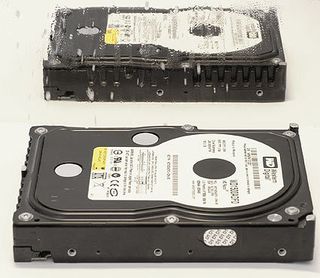Opting for RAID Level Migration
RAID Level Migration Made Possible

During the past few months, we have focused on hard drive performance and data security, because we believe that storage issues are still underrepresented by many technical publications and media outlets. Classic hard drives are and continue to be among the slowest computer components. At the same time, mechanical exposure and typical wear and tear limit hard drives’ long-term reliability. How to combine high-performance and robust data storage is, thus, a key concern.
When purchasing a high-performance computer, you might consider a fast single hard drive or a RAID array of two or more drives . Usually a Western Digital Raptor with 10,000 RPM provides the best possible performance. However, these drives are very expensive. So, why not drop the Raptor and go for two drives with 400 GB and 7,200 RPM? Setting them up in RAID 0 can improve their data transfer rates, which makes this scenario a very attractive choice for power users with high storage requirements.
When it comes to data security, RAID 0 is a questionable option. Increasing the number of hard drives within an array also increases the risk of data loss, because the entire RAID 0 array becomes useless in case a single hard drive fails. Hence, RAID 0 is an absolute no-go to store important data. Yes, you can restore data from a malfunctioning RAID array, but not without investing a lot of money.
So, should you opt for RAID 1 or even RAID 5? And what are you supposed to do if your storage capacity isn’t sufficient anymore, but you just don’t have time to reinstall your system right away? In the past, users or administrators usually had to decide whether they wanted to deploy a single hard drive or a RAID array. And they had to stick with what they chose: Very simple RAID controllers from HighPoint, Promise or Silicon Image - as well as on-board solutions from Intel, Nvidia, SiS or VIA - did not allow one to make any subsequent changes to a RAID array.
Today, Intel and Nvidia’s chipset-integrated storage controllers are capable of running various RAID modes and can even transform them in certain ways while the system is running. It is also much easier today to mirror a system installation from a single hard drive to a RAID 1 setup using a second drive. Users are now given the tools to change their existing storage configurations, which is what we show you how to do here.
Stay on the Cutting Edge
Join the experts who read Tom's Hardware for the inside track on enthusiast PC tech news — and have for over 25 years. We'll send breaking news and in-depth reviews of CPUs, GPUs, AI, maker hardware and more straight to your inbox.
Current page: RAID Level Migration Made Possible
Next Page Single Hard Drive(s) Vs. RAID?Most Popular

